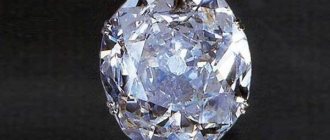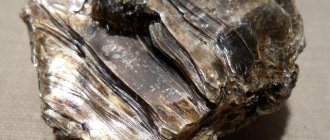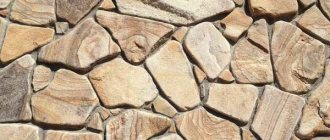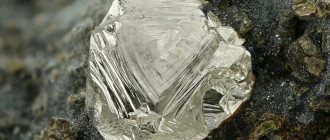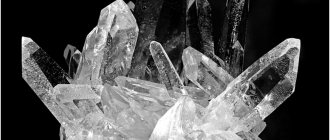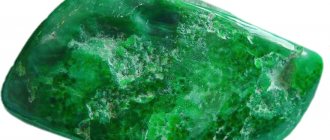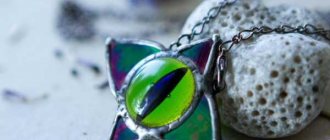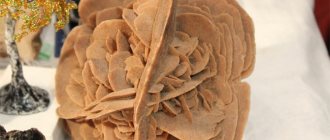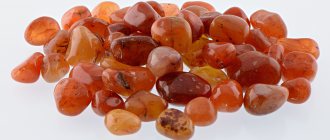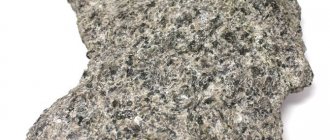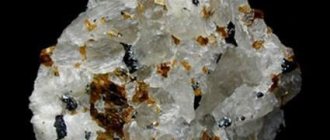Diorite stone is an intrusive rock whose composition is intermediate between gabbro and granite. It is formed in volcanic arcs and in mountain structures, where it occurs in large quantities in the form of batholiths in the root parts of island arcs (for example, in Scotland, Norway). Because this stone has a mottled black and white hue, it is often referred to as “salt and pepper.” Diorite is the plutonic equivalent of andesite.
History and origin
Diorite vases of ancient Egypt
The history of diorite goes back more than 50 million years. Its deposits are formed at the junction of oceanic and continental plates. During the splitting of the oceanic plate, hot basaltic magma rises to the level of the granite slabs and mixes with the granite. As a result of crystallization, the rock diorite is formed. When diorite lava erupts, andesine appears.
From Greek “diorite” is translated as “difference”, “difference”. This characterizes the structure and texture of the rock, in which the boundaries of the constituent minerals are clearly demarcated.
In ancient times, diorite slabs were used as a writing surface. One of the first collections of laws, the code of Hammurabi, was carved on a block of diorite.
Interesting things about the stone
- To date, more than four thousand different types of stones have been studied, including diorite.
- Minerals exist in both gaseous and liquid states. If a stone is melted or evaporated, it will remain a mineral.
- Diorite is sold under the guise of granite, since sellers of natural stones use this name for all rocks that contain feldspar.
- Diorite is also sold as "white granite" and is used in construction.
- It has high strength and is close to diamond in shock resistance.
- This type of stone is very strong, reliable and durable, surpassing even granite in these qualities.
- In terms of age, diorite is a very ancient stone; it dates back more than 50 million years.
- The stone contains feldspar, which is why it has a greenish tint.
- It is not only durable, but also has toughness, and it is this property that gives it excellent wear resistance.
- Diorite has a springing effect that allows it not to split into pieces.
- Its compressive strength reaches two hundred and eighty megapascals.
- In ancient times it was used as paper. For example, the vault of Hammurabi, one of the first collections of laws in human history, was carved on a block of this stone.
Physicochemical characteristics
Quartz Diorite
Diorite is a rock of igneous origin, the basis of which is a number of minerals. Most often, these are plagioclases (oligoclases or andesites), quartz, and hornblende. Less commonly, the basis of diorite is biotite or augite. The proportion of non-ferrous minerals in the composition reaches 30%. Specimens in which the proportion of quartz exceeds 5% are called quartz diorites.
The chemical composition of diorite is silica. The share of more than 50% in its structure is silicon dioxide, in smaller quantities - aluminum oxide, iron, magnesium, calcium, sodium and potassium. The chemical composition of diorite is not constant, so indicators may vary.
Basic physical properties:
| Index | Description |
| Color | ash, gray, dark green, dark emerald, brown, brown-green, smoky |
| Mohs hardness | 8.5 points |
| Compressive strength | 150-280 mPa |
| Density | 2.7-2.9 g/cm³ |
| Shine | oil |
| Transparency | completely opaque |
| Cleavage | absent |
| Texture | homogeneous |
| Other properties | resistance to high temperatures, high humidity, acids and alkalis |
Compound
Diorite stone typically consists of sodium-rich plagioclase with lesser amounts of hornblende and biotite. It usually contains little quartz. This makes diorite a coarse-grained rock with a contrasting mixture of black and white mineral grains.
Diorites consist mainly of feldspar, plagioclase, amphiboles and micas, sometimes with small amounts of orthoclase, quartz or pyroxene.
The chemical composition of the stone is intermediate between the composition of gabbro and felsic granite.
Varieties
Diorite is divided into varieties based on structure, as well as chemical and mineral composition.
Depending on the location of inclusions and their size, the structure of diorites is:
- fine-grained;
- coarse-grained;
- unevenly grained;
- porphyritic.
Hornblende diorite
Depending on the chemical composition, the types of mineral are distinguished:
- mica - brown stones in which mica is one of the main elements in the composition;
- hornblende - painted in dark shades, the composition contains a high content of hornblende;
- augite - specimens of a dark green color, which provides an admixture of augite in the composition.
According to the mineralogical composition, diorites are:
- quartz - light-colored stones in which the quartz content varies between 5-20%;
- quartz-free – the amount of quartz in the composition does not exceed 5%;
- pyroxene - depending on the structure of the crystal lattice, they are clinopyroxene, orthopyroxene and two-pyroxene;
- diorite porphyrites - crystals with large unevenly spaced grains of gray-green, less often brown color;
- Kersantites are a type of mica variety that has a fine-grained structure and is colored in dark shades.
Diorite and andesite
These are similar breeds. They have the same mineral composition and are found in the same geographical areas. The differences are in grain size and cooling rate. Diorite slowly crystallized inside the Earth. This slow cooling produces a large grain size. Andesite forms when magma rapidly crystallizes on the Earth's surface. This rapid cooling produces rocks with small crystals.
The bottom photo of a diorite stone shows the specimen as it might appear on a polished countertop, capstone, or floor tile. It is typically sold as "white granite" at a woodshop or building supply store.
Place of Birth
Deposits of diorite are scattered throughout the planet. It is mined on an industrial scale in the countries of North and South America - Chile, Ecuador, Peru, as well as in the Cordillera.
In Europe, the mineral is mined in Sweden, Norway, and Great Britain. In Ukraine, the Carpathians are famous for their large deposits of diorite.
In Russia, this stone is mined in Kabardino-Balkaria and the Urals.
In Asia, large deposits of diorite are located in Georgia and Kazakhstan (Kapchagaiskoye and Uvalnenskoye deposits).
Diorite quarry
Values
Block ID
Java Edition:
| Name | Identifier |
| Diorite | diorite |
| Polished diorite | polished_diorite |
Bedrock Edition and Java Edition 1.12:
| Name | Identifier | Numeric ID |
| Diorite | stone | 1 |
Data numbering
Main article: Data numbering
| Description | |
| 0 | Stone |
| 1 | Granite |
| 2 | Polished granite |
| 3 | Diorite |
| 4 | Polished diorite |
| 5 | Andesite |
| 6 | Polished andesite |
Block states
Minecraft:stone block states
| Name | Meaning | Description |
| variant | stone | Stone |
| granite | Granite | |
| polished_granite | Polished granite | |
| diorite | Diorite | |
| polished_diorite | Polished diorite | |
| andesite | Andesite | |
| polished_andesite | Polished andesite |
[until 1.13
]
Medicinal properties
Diorite
The main healing property of diorite is the enhancement of the body’s protective properties. This has a beneficial effect on the functioning of all organs and vital systems:
- Accelerates wound healing and restoration of damaged tissue.
- Inflammatory processes are eliminated.
- Vitality increases.
- The psycho-emotional state is normalized - nervous overexcitation, fatigue, depression, apathy and increased anxiety are eliminated. At the same time, mood and performance improve, and a thirst for life appears.
- The aging process slows down.
- Muscle spasms are reduced.
The therapeutic effect is achieved by wearing diorite jewelry, contact with the mineral, or regular visits to diorite baths as prescribed by the attending physician.
Cost of diorite
The price of the mineral depends on:
- on size (solid slab or crumb);
- origin (natural or artificial);
- degree of processing (solid slab or processed countertop).
So, for example, artificial stone costs 800 rubles per 1 kg, natural - 2,000 rubles per 1 kg, processed countertop - 15,000 rubles, sculpture up to 0.5 m high - 6,000 rubles.
Diorite is a mineral that is highly wear-resistant. Looks good as an interior decoration.
Sources
- https://FB.ru/article/464123/kamen-diorit-opisanie-i-svoystva
- https://ogems.ru/vulkanicheskie/diorit
- https://MoyKamen.com/vidy/prochie/diorit-kamen.html
- https://granit2006.ru/porody/diorit/index.shtm
- https://vseprokamni.ru/vidy/drugie/diorit-kamen.html
- https://iRitual.ru/granit/gabbro-diorit/
- https://zakamnem.ru/vidy/diorit
Magic properties
Statue of Gudea, Louvre
Diorite has a beneficial effect on mental clarity, as well as emotional and physical well-being. It teaches prudence and protects against making rash and hasty decisions. For people prone to excitement and wastefulness, the stone gives a sense of proportion and rationality.
The energy of diorite increases vitality and improves mental activity. Wearing a stone helps to sharpen intuition, develop logic and analytical abilities, and increase stress resistance.
A variegated gem will suggest the right solution in extreme conditions, help you navigate the situation and find a way out with minimal losses. It is recommended to take diorite with you to negotiations where controversial issues will be resolved.
The mineral is a talisman for creative individuals. It develops fantasy and imagination, increases ingenuity and inspires new projects. In gifted people, the stone reveals the gift of clairvoyance and extrasensory abilities.
It is believed that with the help of diorite you can establish contact with animals, so it is recommended for veterinarians and trainers to wear it. Diorite should be used as a talisman during long trips.
Diorite and granodiorite
Granodiorites, medium- and coarse-grained rocks, are some of the most significant intrusive igneous rocks. It is composed of quartz and differs from granite in that it contains additional plagioclase feldspar. Its other mineral components include hornblende, biotite and augite. Plagioclase (andesine) usually appears as twin crystals, sometimes completely enclosed within orthoclase. In terms of the method of formation and appearance, physical appearance, mineral composition and texture, granodiorite is in many ways similar to granite. It is darker in color due to its higher plagioclase content.
Application
Due to its high hardness and viscosity, diorite is actively used in construction. Despite these qualities, it is well processed and polished. The stone is used in the following areas:
- Large boulders are used to make countertops, window sills, stair railings, sinks, and tiles for facing fireplaces, walls and floors;
- crushed stone and diorite chips are added to asphalt pavement and concrete mortars to increase wear resistance;
- in landscape design, the rock is used to arrange borders and garden paths; rubble and boulders are used to decorate flower beds and home areas;
- beads and cabochons are made from diorite, which are subsequently inserted into jewelry - beads, bracelets, pendants, earrings, necklaces and rings;
- Decorative elements are cut out of stone - vases, sculptures, frames for watches and photographs, floor lamps;
- pedestals, memorial plaques, monuments and obelisks are made from the rock;
- Diorite is used for arranging saunas and baths.
Product made of diorite
Scope of application of the mineral
Diorite is excellent for use in construction, because it is very hard; damage to a whole huge piece will probably only happen if you use diamond. It is due to these properties that it is very popular, and it is also very similar to granite, which gives it uniqueness and beauty.
From the very beginning, even before our era, this stone was used to create sculptures, instead of granite, which is many times more fragile than diorite. For example: in ancient Egypt, people made a huge number of sculptures, some of which have survived to this day.
It still remains a mystery how they could process this type of stone, since it is difficult and backbreaking work, which is why they have now come up with the diamond “cutting” method, which greatly simplifies this type of activity. Interestingly, the most ancient sculptures were found in Mesopotamia.
Some varieties of the rock are used as cladding material for buildings, or for interior decoration, such as fireplaces. These varieties are those diorites that have a fairly rich shade and are highly polished.
REFERENCE! Quite often you can find various household items, such as floor lamps, vases or tabletops, which are made from this stone.
Much less commonly, diorite is used as a material for laying floors or lining staircase steps. Usually, various types of road stones are made from this rock, which are used for the design of personal plots. Most often this is crushed stone, as well as paving stones, in more rare cases, chips. Such stones should contain no more than five percent grains of weak rocks.
Also read: Scolecite - a stone of peace and harmony
Diorite also has its disadvantages, such as it does not polish well and instead creates a greasy sheen on itself, just like granite or marble.
Diorite has the ability to absorb varnish, so this stone is divided into cabochons and also used as a gemstone. For example, in Australia, beautiful diorite, which had amazing pink inclusions, was cut into cabochons and given the name “pink marshmallow.”
Price
Diorite vase Egypt
The price of diorite depends on the size of the stone, the place of its extraction and the type of product. On average, 1 kilogram of unprocessed stone of natural origin costs $27; when ordering more than 20 tons, the price can be reduced to $23. The cost of artificial diorite, depending on the manufacturer, varies between $10-29 per m².
Diorite crushed stone is cheaper - you will have to pay $13 for 1 ton of stone.
The price of diorite products is higher, since the complexity of the work and the dimensions of the stone are taken into account. For example, the cost of a statue no more than 50 cm high is $82, and a tabletop measuring 100x50 cm is $205.
Diorite jewelry is inexpensive. The price of a pendant made of polished stone in the form of a rectangle is $7, earrings with the same inserts cost $10, and a necklace made of diorite and agate beads costs $43.
Historical use
Diorite is an extremely heavy stone that is so difficult to work with that ancient civilizations (such as Ancient Egypt) used balls of it to cut granite. Its hardness, however, allows diorite to be well processed and polished, and also ensures the durability of products made from it.
One of the relatively common uses of diorite is for inscriptions. Perhaps the best known work in existence is the code of laws of Hammurabi. It is carved on a 2.23 m stele made of black diorite. The original of this work can be seen today in the Louvre in Paris. The use of diorite in art was very important in early Near Eastern civilizations such as Ancient Egypt, Babylon, Assyria and Sumer. The stone was so valuable that the first great Mesopotamian empire (the Akkadian Empire) considered its capture as a goal for military expeditions.
Who is suitable according to their zodiac sign?
Diorite is suitable for all zodiac signs, as it has positive energy.
The stone will reveal its properties to the maximum in front of Scorpios. Representatives of this sign can count on his help in solving the most difficult issues.
Diorite has a neutral attitude towards Libra. They will not receive help from the mineral, but they will not feel any negative effects on themselves either. This zodiac sign can wear the stone only as decoration.
Other representatives of the Zodiac circle will be able to feel the impact of diorite in any one area.
Usage
In areas where diorite occurs near the surface, it is sometimes mined for use as crushed stone. It has a strength that compares favorably with that of granite. It is used as a base material in the construction of roads, buildings and parking lots; Used as drainage stone and erosion control.
In the stone processing industry, diorite is often cut into facing stone and tiles. Ashtrays, blocks, paving stones, borders and various stone products are made from it. Diorite stone is sold as "granite". The natural stone industry uses the name "granite" for any rock with visible, interlocking feldspar grains. This makes it easier to discuss with clients who are unsure how to identify igneous and metamorphic rocks.
How to care for diorite
Tumbled diorite for baths
This mineral has maximum strength characteristics. Its hardness is close to corundum, and its impact resistance is close to diamond. Diorite does not dissolve in acids and is not afraid of sudden changes in temperature, shock, exposure to chemicals and moisture.
Thanks to these properties, maintenance of diorite products is reduced to a minimum.
It is enough to periodically clean the stone from contaminants in the form of dust, dirt and grease stains. To do this, you can use special care products for natural stones.
What is diorite?
Diorite is the name of a group of coarse-grained igneous rocks that consist of granite and basalt. The rock often forms over a convergent plate boundary where the oceanic plate dips below the continental plate.
Partial melting of the oceanic plate results in the formation of basaltic magma, which rises and penetrates the granitic rocks of the continental plate. There, basaltic magma mixes with granite or melts granite rocks as it rises along the continental plate. This produces a melt that is intermediate in composition between basalt and granite. Diorite forms when such a melt crystallizes below the surface.
How to distinguish from fake and other minerals?
The demand for diorite led to the creation of its artificial analogue, which in terms of properties and composition is far from the sample.
Artificial diorite is made from gypsum or concrete compounds in the form of decorative slabs. In terms of color palette and texture, it is similar to natural stone, but does not have its beneficial natural properties. It is easy to distinguish such an analogue - the strength of concrete and gypsum is much lower than the strength of diorite, and the pattern is uniform in comparison with the analogue.
In composition and origin, diorite is very close to granite, so they are often confused. The difference between the minerals is the amount of quartz in the composition (diorite has a lower percentage of quartz) and the contrast of the pattern (granite has more muted colors).
The difference between these two breeds can be seen after polishing. Polished granite has a glassy sheen, while diorite has a greasy, oily, muted sheen.
Diorite is also easily confused with andesite. Both minerals are identical in composition and are formed in close proximity, however, due to different cooling rates in the bowels of the Earth, they have different grain sizes. Andesite has a smaller grain size than diorite.
Diorite stone. Properties of diorite. Applications of diorite
This breed has preserved the heritage of its ancestors for historians. We're talking about diorite. In Ancient Egypt, sculptures were made from it, and pyramid crypts were lined with stone.
Where other rocks were destroyed, diorite remained pristine. There is no mysticism here. It's just a matter of the quality of the stone. It is much harder than iron.
In the minds of modern man, the symbol of reliability is granite. But, compared to diorite, it is more brittle.
In the same Egypt they also worked with granite and made obelisks from it. They were carved with diorite tools, which clearly shows the superiority of the latter stone.
Its strength has allowed hundreds of statues, buildings, and weapons to survive to this day.
In Giza, for example, near Cairo, archaeologists found several diorite bowls without a single chip. So, the breed deserves detailed consideration.
Description and properties of diorite
Diorite is a stone of igneous origin, like granite. This means that the rock is formed at depths, “born” from magma at temperatures of thousands of degrees.
The basis of diorite is the mineral plagioclase. About 30-40% are non-ferrous minerals. Their "company" may vary.
Sometimes, for example, the rock contains pyrite. This is iron pyrite of golden color.
It gives diorite a special luminosity, but reduces the vaunted hardness of the stone. The admixture of mica also reduces it.
In its standard state diorite is a rock whose hardness exceeds 8 on the Mohs scale.
It ends at 10. This position is occupied by diamond. In front of it is 9-grade corundum, which is approximately equal to diorite.
The composition of the ancient tools with which it was processed is a mystery to scientists. There was no diamond cutting method yet, but there were sculptures and slabs made of diorite. The most ancient ones were found in Mesopotamia.
Diorite is not only hard, but also tough. This is what ensures the high wear resistance of the rock.
When struck, it seems to grab the “offenders”, preventing them from splitting her. Compressive strength reaches 280 megapascals.
In addition to the springy effect, the absence of cleavage, that is, the tendency to split along certain planes, also helps.
This is not typical for granular rocks, but diorite is just that. The grains that make up the stone can be both small and large.
The first option is appreciated. Coarse-grained samples are inferior in strength.
The color of the rock depends on its composition. Gabbro diorite is unusually dark, usually gray tones.
In other cases, the stone has a leucocratic appearance, that is, a minimal amount of black inclusions.
Quartz diorite , for example, is almost white, with brown inclusions.
Oligoclase is also responsible for milky tones. Diorite-andesites are common .
They are light gray or brownish. Hornblende in the breed is the key to its greenish color.
Smooth diorite looks especially advantageous . Unlike processing, many types of stone can be easily polished.
True, the shine of the blocks is greasy, there is no clear reflection, like, for example, marble.
Diorite slabs are used in the construction industry and furniture production. But we’ll talk about this separately.
Applications of diorite
answers to the question of what can be made from diorite . Mentioned about statues. But modern sculptors rarely create them.
Working with hard stone diorite is too difficult. It is more often used for pedestals than for statues themselves.
Of course, they don’t build pyramids either, but they do make crypts and tombstones. Exclusive tabletops and vases are also made from diorite.
Volcanic rock can be used to lay window sills, floors, and street paths.
As a road stone, diorite is usually used for curbs. The crushed rock is used as crushed stone.
If we turn to antiquity, diorite was even used as writing paper.
For example, the vault of Hammurabi is carved on blocks of volcanic rock. This is the first legislative collection in the history of mankind.
When Hammurabi was written, people had not yet begun to produce artificial stones. In the 21st century this is the norm.
Therefore, buy unnatural diorite , for example, in the form of decorative slabs.
They cover fireplaces, walls, and decorate the facades of houses. The composition of such a stone, as a rule, is far from the original source; it is a concrete or gypsum mixture.
Therefore, one cannot count on repeating the properties of diorite. Only the characteristic colors and textures are repeated.
diorite is “mined” only in construction stores.
But where do they get natural rock? The question is relevant due to the rarity of diorite. It belongs to the granite group, but is not so common.
There are only a few industrial deposits. Let's get acquainted with their geolocation.
Diorite mining
The main deposits are located in America. Deposits are being developed both in the South and North of the continent: in the Cordillera, Chile, Peru, and Ecuador.
There is a lot of diorite in Northern Europe. The breed is actively mined in Sweden and Norway. Countries rich in diorites also include Great Britain.
Stone from the CIS block is supplied by Kazakhstan. There are two large deposits here. In the Kustanay region, Uvalnenskoye is being developed, and in Alma-Ata, Kapchagayskoye.
There is also diorite in Ukraine , a photo of which can be taken in the Carpathians. Here the rock is located in the form of stocks.
This is what geologists call vertical bodies that resemble pillars. There are similar ones in Georgia, at the Tsipinskoye field.
In Russia, only the Ural Mountains can “boast” of diorites. In them, the rock is associated with iron ore mineralization.
The deposits of the Urals are not large; they are developed exclusively for building stone.
From the geography of diorite deposits it is clear that they are all located in folding zones. It turns out that the rock is formed where the mountains are.
Determining the age of diorites, geologists came to the conclusion that the formation of the stone can take place both at the initial stages of folding and at its end.
In the case of the Ural diorites, their “birth” took place at the final stage of tectonic processes.
Diorite price
Artificial diorite is sold by the square meter. Depending on the collection and manufacturer, you can pay from 800 to 2,200 rubles.
At the same time, the thickness of the blocks is approximately 2 centimeters. This is the maximum if the surface of the slabs is uneven.
If you order natural diorite , you have to figure out about 2,000 rubles per kilo.
At the same time, minimum orders are usually 20 tons. These are, for example, the conditions of Ukrainian enterprises. Over 20 tons of stone are sold at 1,700 rubles per kilo.
Completely different prices for crushed stone. Here you will pay about 1,000 rubles, and not for a kilo, but for a ton of crumbs. Why is it needed?
Crushed stone from diorite is used, for example, as a road surface in icy conditions. A fraction of no more than 2.5 millimeters is needed.
Larger crushed stone is useful in landscape design, and also as rubble for concrete.
The cost of finished diorite products depends on the scale of the crafts, their design and quality. As a rule, we are talking about tens of thousands.
So, for a tabletop 1 meter long and 50 centimeters wide they ask for a minimum of 15,000 rubles.
True, countertops, for example, kitchen ones, are also made from compressed chips.
In this case, the price tag is about half as much. By the way, shells are also diorite.
